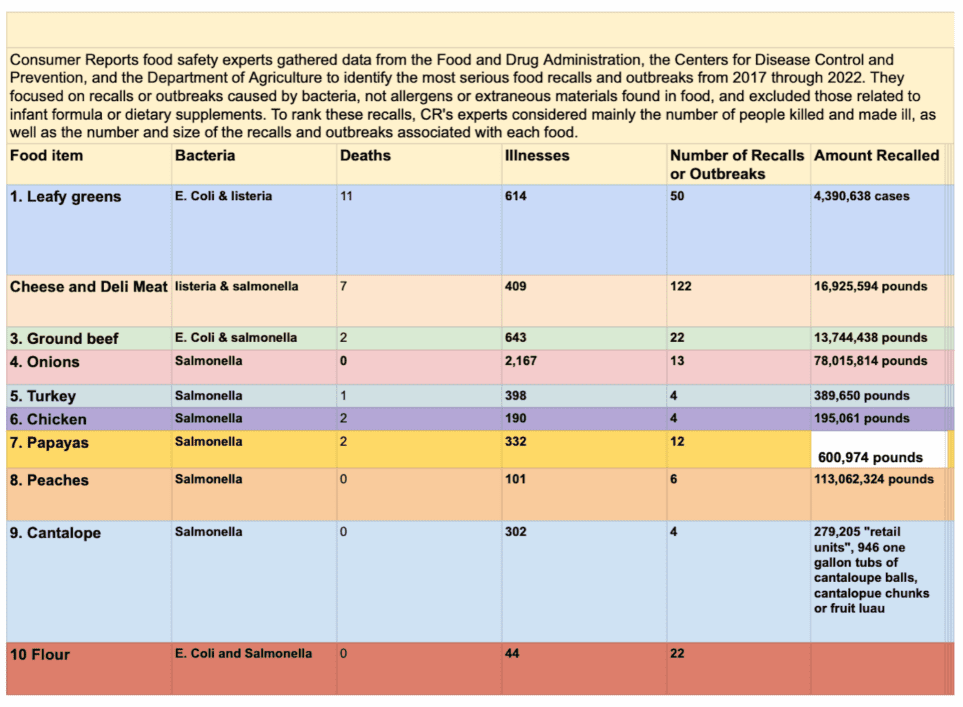Consumer Reports (CR) has published a list of the ten riskiest and most recalled foods on the market.
Fresh produce does not come off well. Indeed, five of the most recalled items are fresh fruits and vegetables: leafy greens, onions, papayas, peaches, and cantaloupe. (See attached chart for the full list and rankings.)


“We aren’t saying people need to avoid these foods entirely,” says Brian Ronholm, director of food policy at CR, who led the analysis. “After all, these foods are all usually safe, and many of them are in fact important parts of a healthy diet.”
Instead, he says, the list underscores the “importance of following best food safety practices with all of your foods, including knowing how to track, and respond, to food recalls when they happen.”
Leafy greens came out on top.
“Outbreaks traced to leafy greens were responsible for the most deaths in our analysis, and the second largest number of recalls and outbreaks—50, in fact, compared with 30 for chicken, turkey, and ground beef combined,” says CR. “A likely culprit: contaminated water used to irrigate the fields in California and Arizona, where most of the lettuce is grown in the U.S.,” CR notes. “Some fields are near cattle feedlots, and the animals can carry particularly deadly strains of E. coli, such as O157:H7, in their intestines. Manure containing the bacteria can seep into irrigation water and contaminate the crops.”
Onions: “Here’s the first big surprise in our list,” says CR. “How did they end up here? Mostly because of two very large recalls of red, white, and yellow onions due to salmonella in 2020 and 2021. . . . Together, onions from both recalls sickened 2,167 people and hospitalized 427.”
“For peaches,” CR continues, “the contamination appears to stem from animal feedlots. For example, in its investigation of a 2020 recall of nearly 113 million pounds of that fruit, the FDA found that the peach orchards were near feedlots, and some of those orchards tested positive for salmonella strains similar to those previously found in cattle and poultry. In this case though, it might not have been in the irrigation water, but in dust and soil contaminated with the bacteria carried by wind and deposited on crops.”
For papayas, the highest risk comes from fruits imported from Mexico, “reflecting the difficulty the FDA [Food and Drug Administration] can have when inspecting production outside the U.S.”
Problems with cantaloupes and melons “seem to emerge most often when the fruits are cut into cubes or balls before selling,” according to CR.
CR’s examination “focused on widely consumed foods that were recalled because of bacterial contamination (not because of allergens or extraneous materials like the plastic particles that sometimes get into foods). They ranked the recalls mainly on how many people died or became ill, as well as how widespread the outbreaks were, how many times a food was recalled, and the total amount of food recalled.”
Here is a link to the report’s methods of analysis.
The findings are not entirely surprising, but it is odd to consider that fresh fruits and vegetables are among the foods most prominently marked out as dangerous to consume. Of course that is because the cases pinpointed here lead to actual and direct illnesses and deaths. More chronic but less acute health problems linked to processed foods (diabetes, obesity) are not highlighted.
One obvious conclusion is that the produce industry needs to have much more direct and frank discussions with livestock producers in order to stave off future bacterial contaminations.



